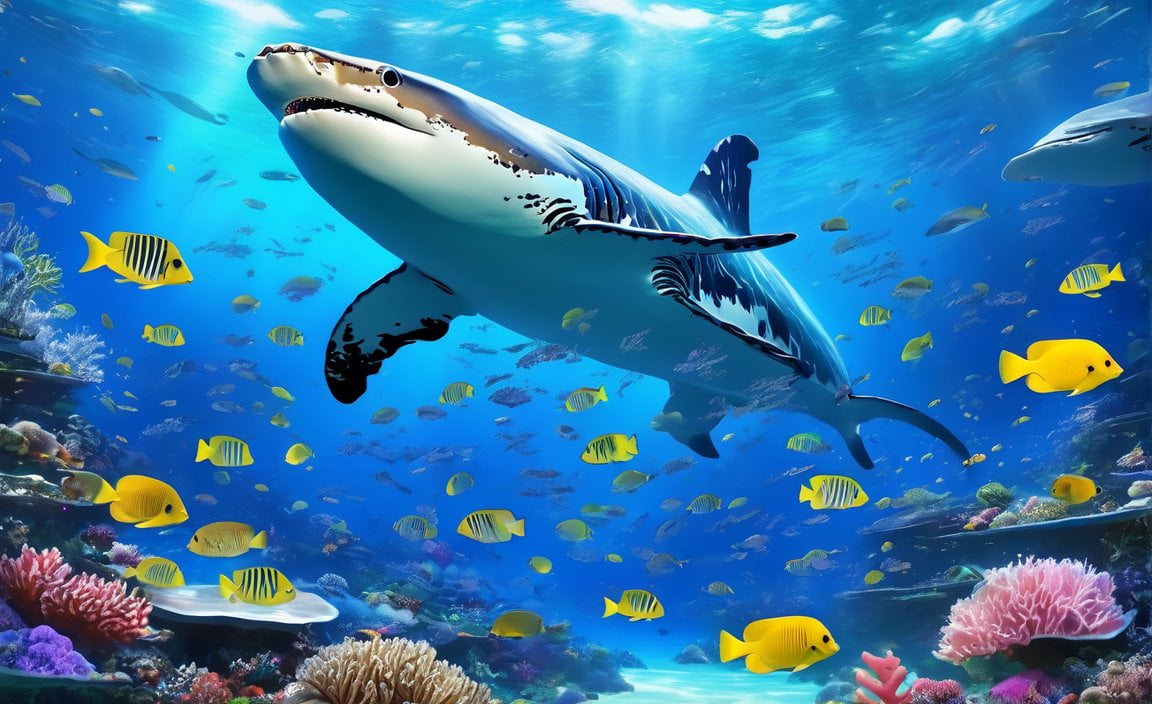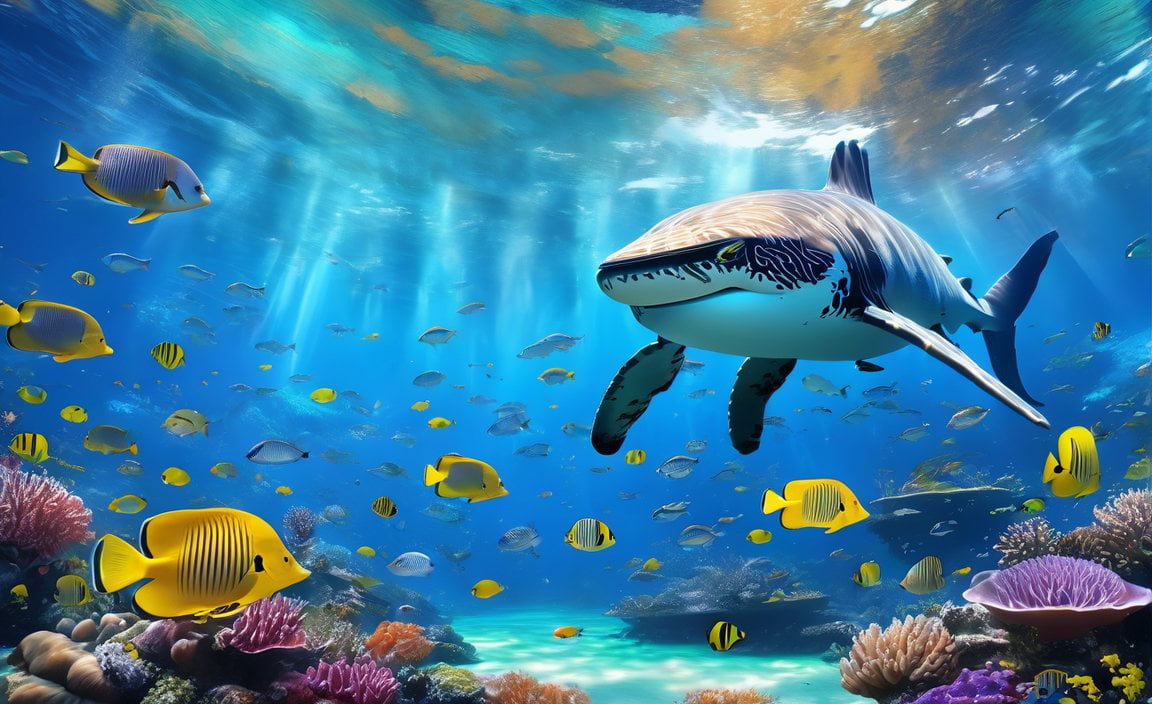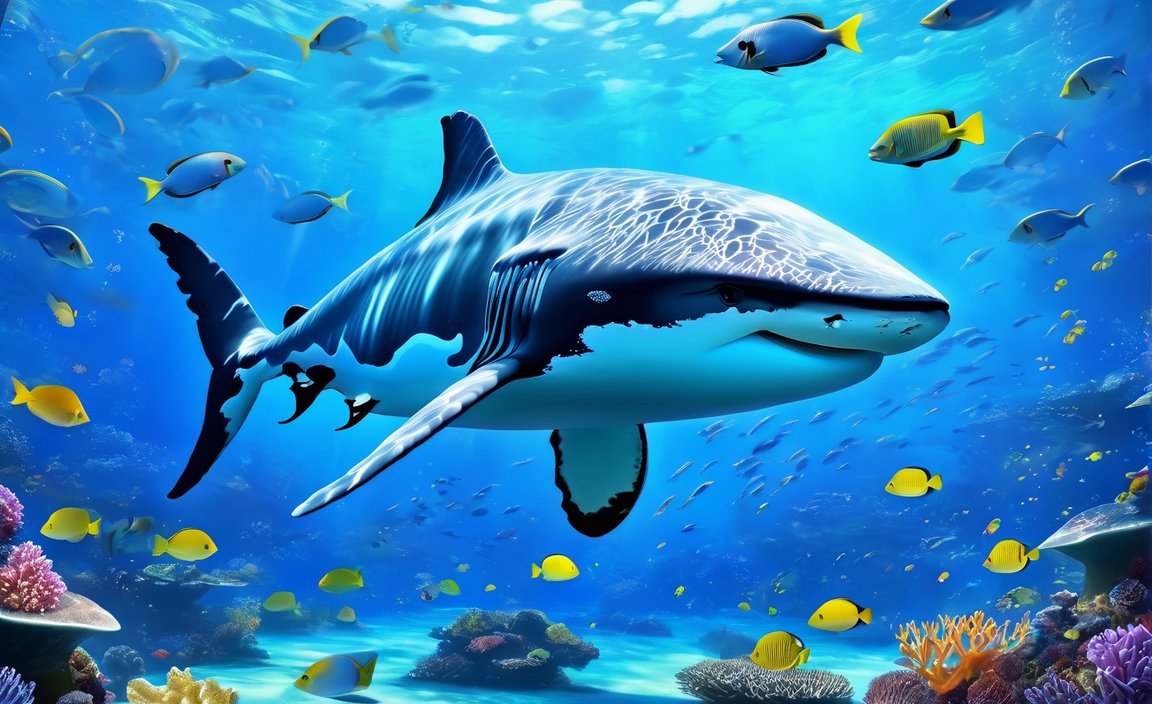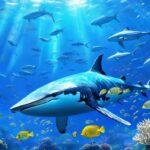Discover 5 Fascinating Marine Life Facts: Delve into the mesmerizing world of oceanic wonders with this captivating collection of intriguing facts about marine life. From the mysterious behavior of deep-sea creatures to the mind-boggling adaptations of coral reefs, these five revelations will leave you in awe of the incredible diversity and resilience of our underwater ecosystems. Prepare to be amazed as we delve into the secrets of the sea and unlock the hidden treasures that lie beneath the surface.

Key Takeaways:
- Around 70% of the Earth’s surface is covered by oceans and they hold about 96.5% of all water on the planet.
- The Pacific Ocean is the largest ocean, covering approximately 30% of the Earth’s surface.
- There are over 230,000 known species of marine life in the oceans, showcasing incredible diversity.
- The oceans play a vital role in supporting aquatic food webs and coral reef ecosystems, contributing to the Earth’s overall ecosystem.
- Seafood from the oceans is crucial for feeding the growing global population.
- The oceans provide habitats for a wide range of marine animals, including sharks, sea turtles, and various ecosystems such as coral reefs.
- The oceans encompass various habitats such as the shoreline, deep sea, and underwater volcanic vents.
- Due to their vastness, the oceans are responsible for enshrouding the planet in darkness.
- The largest ocean waves occur beneath the surface of the oceans.
- The oceans cover 99.9% of the planet’s habitable space.
- The World Wide Fund for Nature (WWF) strives to protect and conserve the oceans and marine life.
Sources:
1. Ocean facts! – National Geographic Kids
2. Marine Life Encyclopedia – Oceana
5 Facts About Marine Life
The ocean is a mysterious and captivating world that is teeming with life. From the tiniest organisms to the majestic giants, marine life never fails to amaze us. In this article, we will explore [5 facts about marine life] that will not only pique your curiosity but also deepen your understanding of the intricate web of life beneath the waves.
Fact 1: Marine Life Abounds in Diversity
The vastness of the oceans harbors an astonishing variety of species. In fact, there are over 230,000 known marine species, each with their own unique adaptations and ecological roles. From colorful coral reefs to the depths of the abyss, marine life thrives in a myriad of environments. It is this diversity that makes the oceans a true treasure trove of biological wonders.
Fact 2: The Oceanic Realm is Earth’s Dark Secret
Have you ever thought about the vast darkness that shrouds our planet? Well, the oceans are the primary culprits. Their immense size absorbs and scatters light, enveloping our planet in twilight. Below the surface, where sunlight fades, bioluminescent creatures illuminate the depths, creating a mesmerizing spectacle like no other.
Fact 3: The Great Pacific Ocean, a Titan of the Seas
If there were a crown for the largest ocean on Earth, the Pacific Ocean would undeniably wear it. Spanning approximately 30% of the Earth’s surface, the Pacific Ocean reigns supreme. With its mighty waves and awe-inspiring depths, it serves as a testament to the sheer power and majesty of our planet’s oceans.
Fact 4: The Oceans Nurture Fragile Coral Reefs
Coral reefs are not just colorful underwater landscapes; they are intricate ecosystems that support a staggering amount of marine life. These fragile structures provide shelter, food, and breeding grounds for countless species. However, they face numerous threats, such as coral bleaching and habitat destruction, making their conservation a matter of utmost importance.
Fact 5: The Underwater Volcanic Vents, Hidden Havens
Deep beneath the ocean’s surface lie mysterious and otherworldly worlds—underwater volcanic vents. These vents release scorching water, minerals, and gases into the depths, creating unique habitats that defy conventional wisdom. Despite the extreme conditions, life thrives in these environments, showcasing the resilience and adaptability of marine organisms.
In conclusion, the realm of marine life is a captivating and vital part of our planet’s ecosystem. From the incredible diversity of species to the hidden treasures lurking in the depths, there is so much more to discover and protect. So, dive into the depths of knowledge and explore the wonders of marine life. Together, let us strive for a future where the oceans and all their inhabitants continue to thrive.
Here are some fascinating topics about marine biology, ocean animals, ocean life, and ponds that you don’t want to miss:
-
5 facts about marine biology: Dive deep into the amazing world of marine biology and discover the wonders that lie beneath the ocean’s surface.
-
5 facts about ocean animals: Explore the diverse and incredible creatures that inhabit our oceans. Learn interesting facts about these fascinating ocean animals.
-
5 facts about ocean life: Immerse yourself in the beauty and complexity of ocean life. Discover intriguing facts about the delicate ecosystems and the remarkable organisms that call the ocean their home.
-
5 facts about ponds: Take a stroll by the serene ponds and unravel the secrets they hold. Delve into the enchanting world of ponds and uncover interesting facts about their inhabitants and ecosystems.
Click on the links above and be prepared to embark on a journey of knowledge and wonder!
Oceans are the Largest Habitat on Earth, Supporting Diverse Marine Ecosystems
The world beneath the ocean’s surface is a captivating realm, teeming with life and filled with hidden wonders. As we delve into the depths, we uncover a multitude of fascinating facts about marine life that showcase the oceans as the largest habitat on Earth, supporting diverse marine ecosystems. Let’s embark on an intriguing journey to explore these five remarkable aspects of marine life.
The Great Barrier Reef: A Vibrant Underwater City
Imagine a bustling metropolis hidden beneath the waves. The Great Barrier Reef, located off the northeastern coast of Australia, is a sprawling underwater city that stretches over an astonishing 2,300 kilometers (1,430 miles). This magnificent structure, visible even from space, is composed of billions of tiny coral polyps working in harmony. It is home to an incredible variety of marine organisms, including over 1,500 species of fish and 600 types of corals. This thriving ecosystem not only showcases the breathtaking beauty of marine life, but also plays a crucial role in protecting coastlines from storms and providing sustenance to countless organisms.
Deep-Sea Discoveries: Unveiling Mysteries of the Abyss
Prepare to be astounded by the mysteries of the deep sea. Beneath the sunlit surface lies a world of darkness, where peculiar and otherworldly creatures reside. The exploration of the deep sea has revealed astonishing finds, including the astonishing fact that there may be over 230,000 known marine species, each with their own unique adaptations and ecological roles. From glowing bioluminescent creatures to fearsome predators with jaws that can swallow prey larger than themselves, this enigmatic realm continues to captivate and surprise scientists and enthusiasts alike.
Marine Migration: Epic Journeys Across the Oceans
Imagine embarking on an epic journey across vast oceans, navigating obstacles and relying on finely tuned instincts. Marine migration is an extraordinary feat undertaken by many species, showcasing the resilience and adaptability of marine life. From the impressive annual migration of humpback whales, traveling up to 8,000 kilometers (4,970 miles) from their feeding grounds to breeding grounds, to the incredible navigation skills of sea turtles, who return to the same beach where they were born, these migratory journeys are a testament to the interconnectedness of marine ecosystems and the importance of preservation.
Symbiotic Relationships: Nature’s Perfect Partnerships
In the marine world, collaboration and mutual benefit are key to survival. Symbiotic relationships between different species form intricate webs of interdependence and cooperation, ensuring the delicate balance of marine ecosystems. From the symbiotic bond between clownfish and sea anemones, where the clownfish receives protection and the sea anemone gains nourishment, to the remarkable relationship between cleaner fish and their “clients,” where the clients are treated to a meticulous cleaning service in return for a meal, these partnerships highlight the interconnectedness and complexity of marine life.
Ocean Connectivity: The Global Life Support System
The oceans are not isolated bodies of water but rather a connected network that contributes to the well-being of the entire planet. Just as the circulatory system sustains our bodies, the vast ocean currents play a pivotal role in regulating Earth’s climate, distributing heat and nutrients across the globe. These currents also facilitate the dispersal of marine species, shaping the biodiversity of different regions. Understanding and protecting this intricate web of connectivity is crucial for the preservation of marine ecosystems and the future of our planet.
Key Takeaways:
- The Great Barrier Reef is a sprawling underwater city that supports a diverse range of marine life, showcasing the beauty and importance of coral reefs.
- The exploration of the deep sea has unveiled an incredible range of unique and mysterious marine species.
- Marine migration highlights the resilience and interconnectedness of marine ecosystems, with species undertaking epic journeys across vast oceans.
- Symbiotic relationships between different species contribute to the delicate balance of marine ecosystems and showcase nature’s perfect partnerships.
- The oceans are a global life support system, connected through ocean currents that regulate Earth’s climate and shape marine biodiversity.
Sources:
– National Geographic Society – Marine Ecosystems
– Ocean Wise – The Ocean Supports Diversity
Marine Life: A Crucial Player in Global Nutrient Cycling and Climate Regulation
Marine life is not just a stunning spectacle of colorful creatures and vibrant ecosystems; it also plays a vital role in global nutrient cycling and climate regulation. From microscopic organisms to majestic whales, marine life forms an interconnected web that sustains our planet’s delicate balance. In this article, we will delve into five fascinating facts about the pivotal role of marine life in global nutrient cycling and climate regulation.
The Nutrient Transformers
Marine microorganisms, although invisible to the naked eye, are the unsung heroes of nutrient cycling. These tiny creatures have the remarkable ability to rapidly transform nutrients in the atmosphere, land, and oceans. By driving carbon and nutrient cycling, they ensure a continuous flow of vital elements through various ecosystems, making them a critical component of Earth’s biogeochemical cycles.
A Global Challenge for Oceanographers
Understanding the distribution and transformations of marine microorganisms is no easy task. Biological oceanographers face the significant challenge of unraveling the intricate workings of these organisms and their impact on nutrient cycling. By unveiling the mysteries of marine microbial communities, scientists can gain insights into the delicate balance of nutrients in our oceans and maintain the health of these invaluable ecosystems.
The Influence of Global Warming
Global warming poses a profound threat to marine microbial communities. As ocean temperatures rise and other factors like acidification, oxygen content, circulation, stratification, and nutrient inputs change, these delicate ecosystems face significant disruptions. These changes can have far-reaching consequences for nutrient cycles and the overall ecological balance, potentially impacting the survival of countless marine species.
Deciphering Nutrient Limitations
The availability of macro- and micro-nutrients is a critical factor that determines the biological activity of marine microbes worldwide. Identifying the limiting nutrient and understanding nutrient bioassays are essential for unraveling nutrient limitations. By deciphering the complex interplay between nutrients and marine life, scientists can ensure the proper availability of essential elements, safeguarding the health of marine ecosystems.
Exploring Biochemical Transformations
Researchers have made significant advancements in quantifying marine nitrogen cycle pathways through enzymatic and isotopic approaches, aided by advances in analytical instrumentation. These developments have provided critical insights into the complex biochemical transformations performed by marine microbial communities. By decoding these transformations, scientists gain a deeper understanding of the intricate workings of marine life and its role in nutrient cycling.
Key Takeaways:
- Marine microorganisms are key players in global nutrient cycling, driving carbon and nutrient transformations in the atmosphere, land, and oceans.
- Global warming poses significant challenges to marine microbial communities, impacting temperature, acidification, oxygen levels, circulation, stratification, and nutrient availability.
- Macro- and micro-nutrient availability is crucial for the biological activity of marine microbes, emphasizing the importance of understanding nutrient limitations.
- Scientists employ enzymatic and isotopic approaches, along with advances in analytical instrumentation, to unravel the complex biochemical transformations performed by marine microbial communities.
- The interconnections between marine life and nutrient cycling are essential for maintaining a healthy and balanced ocean environment.
Sources:
- Nature: Marine microorganisms and global nutrient cycles
- PubMed: Impacts of global warming on marine microbial communities
Human Activities Pose Significant Threats to Marine Life and Its Ecosystems
The fragile ecosystems of our oceans are facing major threats due to various human activities. These activities have far-reaching consequences for marine life, its habitats, and the overall balance of our planet. It is essential to understand and address these threats to ensure the preservation and protection of our marine ecosystems. Here are five prominent human activities that pose significant dangers to marine life and its ecosystems:
Rising Temperature of Sea Water due to Global Warming
Source:
– ^17 Major Threats to Marine Biome – Deep Ocean Facts
– ^The World Economic Forum
Global warming, fueled by the increase in carbon dioxide and other pollutants in our atmosphere, is causing a rise in sea water temperatures. This rise in temperature has significant impacts on marine life. Coral bleaching, changes in migration patterns, and the loss of biodiversity are some of the adverse effects of rising sea water temperatures. It is important to address the root causes of global warming and work towards sustainable practices to mitigate its impact on marine ecosystems.
Dumping of Waste Materials from Industries, Ships, and Sewage Plants
Source:
– ^11 Threats to Marine Environment You Must Know
– ^Major Threats to Marine Ecosystem-A Global Issue – ResearchGate
The dumping of waste materials, such as plastics, chemicals, and sewage, into the oceans is a major threat to marine ecosystems. This pollution not only contaminates the water but also harms marine organisms and disrupts the delicate balance of the ecosystem. Strict regulations, proper waste management, and increased awareness can help minimize the harmful effects of waste dumping on marine life.
Land Runoff
Source:
– ^11 Threats to Marine Environment You Must Know
– ^UNESCO Ocean Literacy
The runoff from land, especially in areas with intensive agriculture and urban development, carries pollutants like fertilizers, pesticides, and sediment into the oceans. This runoff leads to eutrophication, harmful algal blooms, and oxygen depletion, severely impacting marine life and habitats. Adopting sustainable agricultural practices, implementing proper stormwater management systems, and promoting responsible land use are crucial in reducing the negative impacts of land runoff on marine ecosystems.
Dredging
Source:
– ^11 Threats to Marine Environment You Must Know
– ^Nature
Dredging, the excavation of the seabed for various purposes like creating shipping channels or extracting minerals, disrupts marine habitats. It destroys essential breeding grounds, alters the sediment balance, and causes sedimentation problems, all of which impact the overall health of the marine ecosystem. Proper planning, monitoring, and implementing sustainable dredging practices can help minimize the negative effects and preserve the integrity of marine habitats.
Overload of Noise from Ships
Source:
– ^17 Major Threats to Marine Biome – Deep Ocean Facts
– ^Futurity
The noise generated by ships, including propeller noise and seismic surveys, has adverse effects on marine life. Since marine animals heavily rely on sound for communication, navigation, and finding food, excessive noise disrupts these critical activities. The consequences include stress, hearing damage, and disturbances in the natural behavior of marine species. Implementing regulations to reduce ship noise pollution and developing quieter ship technologies are crucial steps in protecting marine life from the harmful effects of ship noise.
Key Takeaways:
– Rising sea water temperatures due to global warming have significant impacts on marine life, leading to coral bleaching, changes in migration patterns, and loss of biodiversity.
– Dumping of waste materials into the oceans from industries, ships, and sewage plants contaminates the water and disrupts the delicate balance of marine ecosystems.
– Land runoff, carrying pollutants from intensive agriculture and urban development, leads to eutrophication, harmful algal blooms, and oxygen depletion, severely impacting marine life and habitats.
– Dredging disrupts marine habitats, destroys breeding grounds, and alters sediment balance, causing sedimentation problems and impacting the overall health of the marine ecosystem.
– Ships’ noise, including propeller noise and seismic surveys, disrupts critical activities of marine species and can lead to stress, hearing damage, and disturbances in natural behavior.
Sources:
– Deep Ocean Facts: 17 Major Threats to Marine Biome
– [Marine Insight: 11 Threats to Marine Environment You Must Know] (

FAQ
Q1: How much of the Earth’s surface is covered by oceans?
A1: Around 70% of the planet’s surface is covered by oceans.
Q2: What is the largest ocean on Earth?
A2: The Pacific Ocean is the largest ocean, covering around 30% of the Earth’s surface.
Q3: How many known species of marine life are there?
A3: There are over 230,000 known species of marine life.
Q4: What role do the oceans play in the Earth’s ecosystem?
A4: The oceans play a crucial role in the Earth’s ecosystem by supporting aquatic food webs and coral reef ecosystems.
Q5: Why are the oceans important for feeding the world’s population?
A5: Seafood from the oceans is essential for feeding the world’s growing population.
- Unraveling Einstein’s Legacy: Who Inherited His Genius? - July 14, 2025
- Unlock Einstein’s Family Tree: Bernhard Caesar & Untold Stories - July 14, 2025
- Unveiling Bernhard Caesar Einstein: His Life & Albert Einstein’s Legacy - July 14, 2025
















